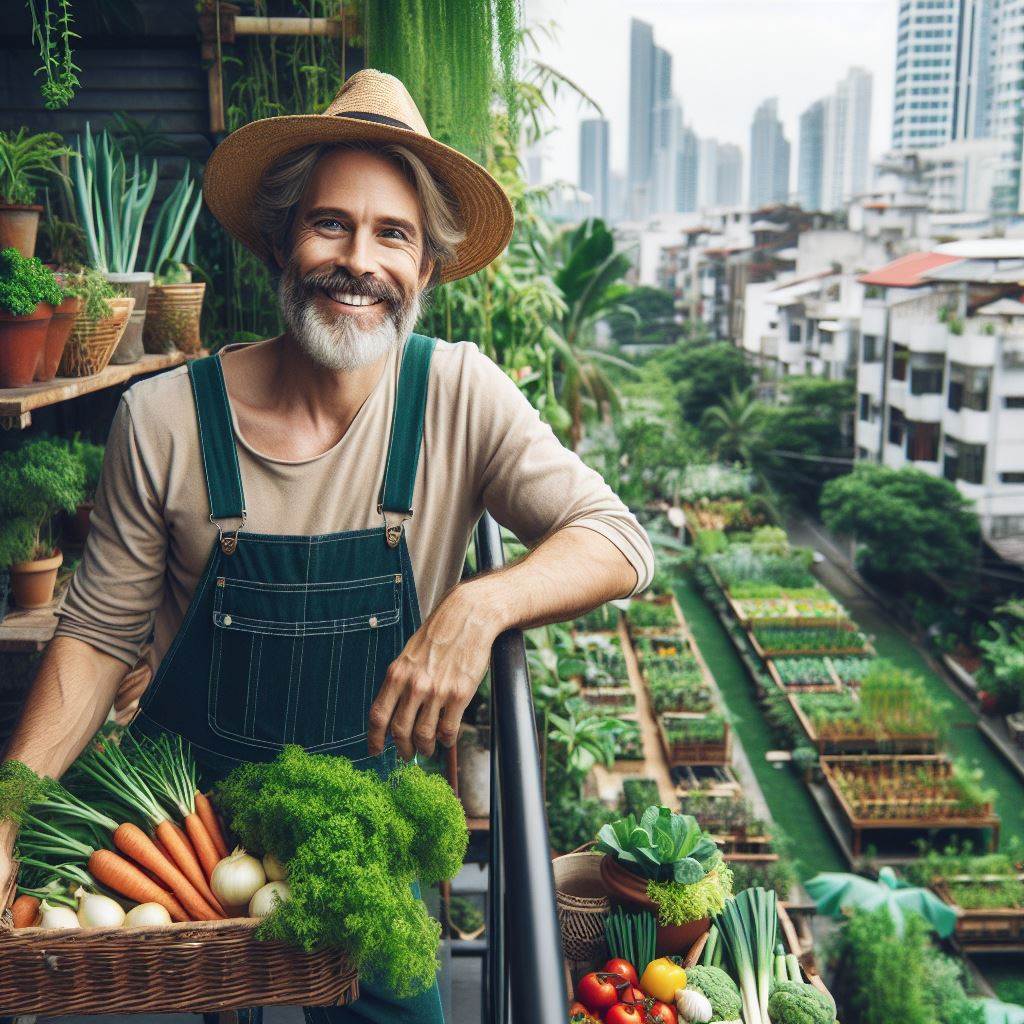Balcony Farms: Grow Food in Small Spaces
Last Updated on February 5, 2024
Introduction
Balcony farms are gaining popularity as urban farming becomes a growing interest.
Growing food in small spaces has numerous benefits that can positively impact individuals and communities.
The objective of this blog post is to provide a comprehensive guide on creating and maintaining successful balcony farms.
Urban farming has become a trend as more people embrace sustainability and self-sufficiency.
Growing food in small spaces, like balconies, allows individuals to have access to fresh and organic produce.
For communities, balcony farms can contribute to food security and reduce their carbon footprint.
Creating a balcony farm requires careful planning and consideration of space, sunlight, and water sources.
The first step is to assess the available space and determine what type of crops can be grown.
Container gardening is a popular choice for balcony farms, as it allows flexibility and easy maintenance.
Choosing the right containers and soil mixture is crucial for proper plant growth and nutrient absorption.
Next, balcony farmers need to consider the sunlight exposure and adjust the layout accordingly.
Some crops may require more sunlight, while others can tolerate shade or partial shade.
Watering is a critical aspect of maintaining balcony farms. It’s important to ensure plants receive adequate moisture.
Regular watering schedules and proper drainage are essential for healthy plant growth.
Fertilizing balcony farms with organic fertilizers helps replenish nutrients in the soil and promotes healthy yield.
Pest control is another important factor to consider. Natural methods like companion planting and insect-repelling plants can be used.
Regular monitoring and early detection of pests can prevent severe infestations.
In short, balcony farms are a practical solution for growing food in small spaces.
With careful planning, proper maintenance, and attention to detail, individuals and communities can enjoy the benefits of balcony farming.
Choosing the Right Plants
The importance of selecting suitable plants for balcony farming
When it comes to balcony farming, selecting suitable plants is of utmost importance. The success of your garden largely depends on the plants you choose.
Here, we discuss the significance of making careful selections and provide tips on how to do so.
Types of Vegetables, Fruits, Herbs, and Flowers
There are several varieties of plants that can thrive in small spaces such as balconies.
Let’s explore the different types:
Vegetables:
- Tomatoes: These are a popular choice as they can be grown in pots and produce a good yield.
- Lettuce: Leafy greens like lettuce are great for balcony farming as they require minimal space.
- Peppers: Both bell peppers and chili peppers can be grown successfully in pots or containers.
- Radishes: These root vegetables mature quickly, making them ideal for small spaces.
Fruits
- Strawberries: These compact plants can be grown in hanging pots or vertical gardens.
- Citrus Trees: Some dwarf varieties of citrus trees can be grown in pots on balconies.
- Blueberries: These small bushes can thrive in containers and provide a delicious harvest.
- Grapes: Some grape varieties, like the miniature ones, are well-suited for balcony gardens.
Herbs
- Basil: One of the easiest herbs to grow, basil can add flavor to your dishes right outside your kitchen.
- Mint: This aromatic herb can thrive in small spaces and is perfect for teas and cocktails.
- Parsley: It grows well in containers and can be harvested continuously throughout the season.
- Thyme: This perennial herb is suitable for balcony gardens as it requires little maintenance.
Flowers
- Petunias: These colorful flowers are easy to grow and can add a vibrant touch to your balcony.
- Geraniums: Known for their variety of colors, geraniums are perfect for balcony pots or hanging baskets.
- Marigolds: These hardy flowers repel pests and can withstand the limitations of small spaces.
- Begonias: With their beautiful blooms, begonias are a favorite choice for balcony gardening.
Considering Climate, Sunlight, and Space Constraints
While selecting plants for your balcony farm, it is essential to consider factors such as the climate, available sunlight, and space limitations.
Here are some tips to help you make the right choices:
- Research the climate zone you live in and choose plants that are well-suited for your specific region.
- Take note of how much sunlight your balcony receives during different parts of the day. Some plants require more sun while others do well in shade.
- Assess the available space on your balcony and select plants that can thrive within those constraints.
- Consider the height and spread of plants to ensure they don’t overcrowd your balcony and hinder movement.
- Think about the care and maintenance requirements of the plants you choose. Opt for ones that match your gardening skills and available time.
By carefully selecting the right plants for your balcony farm, you can create a lush and productive garden even in limited space. Happy gardening!
Read: Sustainable Fertilizers: A Carbon Fix
Preparing the Balcony
The necessary preparations to create a functional balcony farm
- Clear the balcony of any debris or unnecessary items.
- Assess the balcony structure to ensure it can support the weight of a mini-farm.
- Check the capacity of the balcony for weight and consider getting professional advice if needed.
- Choose an area on the balcony that receives sufficient sunlight for various plants.
- Consider using hanging planters to maximize space and create a visually appealing vertical garden.
- Vertical gardening systems, such as wall-mounted planters or trellises, can also be beneficial for smaller spaces.
- Utilize raised beds to create a more ergonomic gardening experience and maximize planting space.
- Ensure proper drainage by using containers with drainage holes or adding a layer of gravel at the bottom.
- Prepare the soil by using a nutrient-rich potting mix or organic compost.
- Consider adding a layer of mulch to help retain moisture and suppress weed growth.
The importance of assessing the balcony structure and capacity for weight
No matter what type of garden setup you decide to go with, it’s crucial to assess your balcony’s structure and weight capacity.
Balconies are built to withstand a certain amount of weight, and exceeding this limit can be dangerous.
If you’re unsure about the balcony’s capacity, it’s best to consult a professional who can assess the situation and provide guidance.
Once you’ve cleared the balcony of any unnecessary items, it’s time to start planning your mini-farm.
Choose an area on the balcony that receives sufficient sunlight throughout the day.
Most plants require at least six hours of direct sunlight to thrive, so make sure your chosen spot meets this requirement.
Using hanging planters, vertical gardening systems, and raised beds for maximizing space
Hanging planters are a great way to add greenery to your balcony while maximizing space.
They can be easily hung from railings or hooks and allow for cascading plants to create a visually appealing display.
You can choose from a wide variety of hanging planters, including traditional baskets or modern self-watering systems.
Vertical gardening is another option for small balconies. Wall-mounted planters or trellises can be used to grow climbing plants, herbs, or even compact vegetables like cherry tomatoes.
These systems not only save space but also add a decorative element to your balcony.
Consider utilizing raised beds to create a more ergonomic gardening experience while maximizing your planting space.
Raised beds can be constructed using wood or other suitable materials and allow for better soil drainage.
The importance of proper drainage and soil preparation to ensure healthy plant growth
Proper drainage is essential for a successful balcony farm. Ensure that your plant containers have drainage holes to prevent water from pooling and causing root rot.
If your containers lack drainage holes, you can layer the bottom with gravel or small stones to create a reservoir for excess water.
When preparing the soil for your balcony farm, it’s essential to use a nutrient-rich potting mix or organic compost.
These will provide the necessary nutrients for your plants to grow and thrive. Additionally, consider adding a layer of mulch to help retain moisture, prevent weed growth, and insulate the soil.
By following these preparations, your balcony farm will have a solid foundation for healthy plant growth and fruitful yields.
Remember to regularly assess the structure’s weight capacity and adjust accordingly to ensure a safe and successful mini-farm.
Read: Permaculture Zones: Effective Planning

Caring for Balcony Farms
Essential Care Routines for Maintaining Balcony Farms
- Ensure proper drainage by using containers with drainage holes and placing saucers underneath to catch excess water.
- Regularly monitor soil moisture levels by inserting your finger into the soil to determine if it’s dry or damp.
Watering Techniques
Water the plants deeply, making sure the water reaches the roots and doesn’t just wet the surface.
Use a watering can or a hose with a nozzle that provides a gentle shower-like spray to avoid damaging the plants.
Water the plants early in the morning or late in the evening to prevent rapid evaporation.
Water the plants more frequently during hot and dry periods.
Importance of Monitoring Soil Moisture Levels
Monitor soil moisture levels regularly to prevent both under and overwatering.
Underwatering can lead to nutrient deficiencies and stunted plant growth.
Overwatering can suffocate the roots and promote the growth of root rot and fungal diseases.
Regular Fertilization
Feed your balcony farm plants with organic fertilizers to provide essential nutrients.
Compost, vermicompost, and fish emulsion are excellent choices for organic plant nutrition.
Follow the instructions provided on the fertilizer packaging for proper application.
Pest Control and Eco-friendly Methods
Regularly inspect your plants for signs of pests such as aphids, mites, and snails.
Use neem oil, a natural and eco-friendly insecticide, to control common pests.
Introduce beneficial insects like ladybugs and lacewings to control pests without harming the environment.
Remove any fallen leaves or debris that may attract pests and create a breeding ground for diseases.
Encourage biodiversity by growing companion plants that repel pests, such as marigolds and basil.
By following these essential care routines, your balcony farm will thrive, providing you with a bountiful harvest.
Read: Water Wise: Urban Farming Irrigation Tips
Harvesting and Enjoying
When and how to harvest the crops from the balcony farm
One of the most rewarding aspects of having a balcony farm is the ability to harvest your own crops.
It not only allows you to enjoy fresh and flavorful produce but also gives you a sense of accomplishment.
Let’s explore when and how to harvest the crops from your balcony farm.
Tips on cutting herbs and fruits and vegetables at the optimal time
Knowing the optimal time to harvest your crops is crucial for maximizing their taste and nutritional value.
Different plants have different maturity periods, so it’s important to pay attention to each crop’s specific needs.
For leafy greens like lettuce and spinach, harvest the outer leaves when they are full-sized, ensuring the younger inner leaves continue to grow.
This way, you can have a continuous supply of fresh greens.
When it comes to herbs, such as basil and cilantro, it’s best to harvest them before they flower. This is when their flavors are most concentrated and aromatic.
Regularly pinching off the tips will encourage bushier growth.
As for fruits and vegetables, look for signs of ripeness. Tomatoes should be fully colored and slightly softened, while cucumbers should be bright and firm.
Harvesting these at the right time ensures optimal flavor and texture.
The joy of cooking with homegrown produce
Cooking with homegrown produce is a delightful experience that can elevate your meals to a whole new level.
The flavor and freshness of your balcony farm-grown ingredients will enhance any dish.
Imagine the burst of flavor that comes from adding your own freshly picked herbs to a pasta dish or a salad.
The vibrant colors of your homegrown tomatoes and peppers can turn an ordinary salsa into a culinary masterpiece.
Moreover, cooking with homegrown produce has numerous benefits for your overall well-being. Not only does it provide better-tasting food, but it also encourages a healthier lifestyle.
Being more connected to your food promotes mindful eating and emphasizes the importance of nutritious choices.
Sharing your experiences and recipes
If you have a balcony farm and have been enjoying the fruits of your labor, we would love to hear from you!
Share your experiences, tips, and even recipes using the ingredients you’ve grown.
Do you have a favorite dish that incorporates your homegrown produce?
Maybe a unique twist on a classic recipe? Or perhaps some storage and preservation techniques to ensure your harvest lasts longer?
By sharing your knowledge and culinary experiments, you can inspire others to start their own balcony farms and discover the joy of harvesting and cooking with homegrown produce.
In essence, harvesting crops from a balcony farm is a truly gratifying experience.
Knowing when and how to harvest your crops, as well as the joy of cooking with homegrown produce, can significantly impact your overall well-being.
So, embrace the joy of harvesting, cooking, and sharing your experiences with others.
Your balcony farm is not only a source of nourishment but also a platform for connection and growth within your community.
Read: Urban Beekeeping: Buzzing to Sustainability
Conclusion
Balcony farming offers numerous benefits for those with limited space. By using this innovative method, individuals can grow their own food and enjoy the satisfaction of self-sustainability.
Not only does balcony farming provide fresh and organic produce, but it also reduces the carbon footprint and promotes a healthy lifestyle.
The ability to grow food in small spaces is a game-changer for urban dwellers and those in apartments or condos.
It allows people to connect with nature, engage in a productive hobby, and save money on grocery bills.
Balcony farms also offer a sense of accomplishment and pride as individuals witness the growth and progress of their plants.
We encourage readers to start their own balcony farms and experience the joys of growing their own food.
Whether it’s a small herb garden or a collection of potted vegetables, anyone can embark on this journey.
Share your thoughts, questions, and experiences with us. We would love to hear about your balcony farming adventures!
For further guidance on creating and maintaining balcony farms, there are a plethora of resources available.
Online forums, gardening books, and YouTube channels dedicated to urban farming provide valuable insights.
Additionally, local gardening centers and community gardens may offer workshops or classes on the subject.
Remember, balcony farming is not just about growing food; it’s a way to connect with our environment and contribute to a sustainable future.
So, go ahead, utilize your balcony space, and embark on this rewarding journey of growing your own food. Happy planting!


